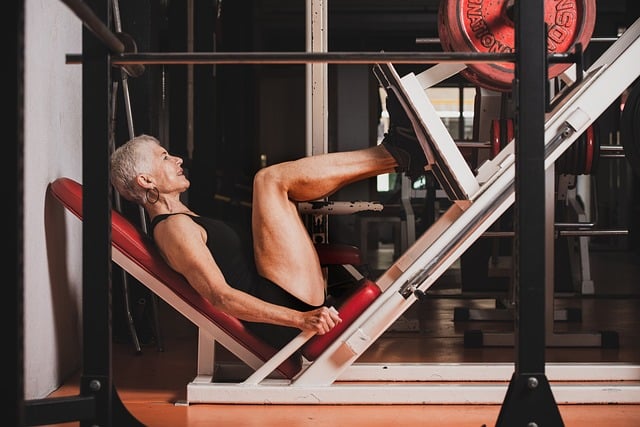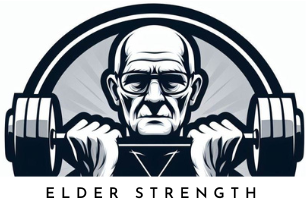In this article, you will learn about weak knees in seniors. What causes it, how to prevent it, and how to fix it with simple steps.
Let’s face it, we’ve all been there. The day you realize your knees can’t take what they used to when you were younger.
You will likely notice this one day while walking down steep stairs, doing a trek, or maybe while squatting down to tie your shoes.
Not to mention doing things like jumping, running, or kicking a ball with the grandkids. These types of activities will quickly tell you if your knees are weak.
In the worst case, they can lead to an injury like an acl tear. Knee injuries are hard and expensive to correct. So it’s a good idea to do your best to prevent them.
The truth is that most people will notice that their knees get sore and feel weaker as they age.
But the good news is that you can do a lot to make your knees stronger, healthier, and pain-free!
Maybe It’s Not Your Knees?
While aging can affect the knee joint, it’s far more likely you are actually experiencing weakness and mobility issues in the muscles and tendons that connect over the knee joint.
On the other hand, there are many medical conditions that can affect your knees.
With medical conditions, it’s important to get the right diagnosis and the appropriate treatment. You can’t usually fix an injury or inflammatory condition with exercise only after all.
The knee joint is a very strong and mobile joint and there are many things that can go wrong with it.
But it’s important to realize that when people talk about having weak knees, they are not always talking about the actual joint.
Weak knees is often a phrase used to describe weak legs.
The problem here is that the issue might not be in the knee joint at all. So the fix is not any kind of direct therapy on the knee joint.
The Job Of The Knee Joint
The job of the knee joint is to just transfer force from your muscles and support your weight while standing and moving.
If you have weak muscles in your legs or hips, this can make it seem like you have weak knees.
For example, you can’t squat down properly without feeling weak or painful in your knees. This is far more likely due to weak and tight leg muscles than an issue with the knee joint.
If you are significantly overweight, this can also cause you to experience knee discomfort. The more you weigh, the harder your leg muscles and joints have to work during everyday activities.
The problem can be higher or lower as well. Weak and dysfunctional hips can cause misaligned movement patterns that put a lot of stress on the knees.
Postural issues or problems with ankle stability can also be felt as unstable knees.
So as you can see, many things can seem like weakness of the knees.
But in all likelihood, if you are not experiencing very sudden and dramatic weakness in your knees, the cause is weak and tight muscles in your legs and hips.
Even if you have an injury, inflammation, or osteoarthritis in your knee joint, strong muscles will help reduce the symptoms by making your knees and legs more stable.
Beware Of Injuries
A common reason for actual knee joint pain, instability, and weakness is injuries. The knee joint is surrounded by connective tissues and cartilage and there are a lot of things that can get injured.
While knee injuries are most commonly associated with athletes, anyone can suffer from them. They often happen when you fall, slip or try to perform sudden strenuous exercise that you are not used to.
They can also happen as a consequence of chronic overuse. This is usually associated with work and both professional and amateur athletes.
The most common knee injuries include connective tissue tears (like the Acl), dislocations, and fractures.
The acute symptom is often pain and swelling and you can’t typically put weight on the knee. If not taken care of properly, a knee injury can cause permanent instability in the joint.
If you have suffered a knee injury, you will likely remember it. But sometimes the injury can be small and the symptoms vague enough to only manifest under certain circumstances.
With injuries, it’s especially important to get the right diagnosis and treatment plan. If you have a very recent injury, it’s important to seek medical advice as soon as possible to avoid scarring and atrophy.
The good news is that many knee injuries can be rehabilitated with physical therapy or surgical intervention.
If your knee weakness is sudden, there is significant pain, swelling, or reduced mobility it’s important you seek medical advice as soon as possible.
In fact, it’s always a good idea to check with your doctor before trying to strengthen your knees on your own. If you have an injury or a medical condition, you can make things worse by trying to remedy it yourself.
Prevention And Fix For Weak Knees In Seniors
So you have ruled out any medical conditions and want to make your knees stronger. But how? Or you don’t have significant weakness in your knees but you want to prevent it from getting any worse.
The solution is fortunately quite easy. To make your knees work optimally, you need to improve mobility and strength in your legs and hips.
If you have been sedentary or have done only monotonous exercise, it’s likely you have some weak and stiff muscles in your legs and hips.
Don’t worry, this is very common. Your legs and knees can work for decades without issues even if you are not taking good care of them.
The most problematic muscle groups are the hamstrings and the quads. But also your calves and hips muscles can affect your knees through posture, gait, and stability.
Flexibility and mobility
The first fix is to work on the flexibility and mobility of your leg muscles.
Flexibility means the passive range of motion and mobility means the active range of motion. So flexibility is very you can stretch a muscle and mobility is where you can move it voluntarily.
Tight hamstring and tight quads can pull the knee joint out of alignment during movement, causing discomfort and pain.
Tight muscles and tendons will also reduce the range of motion of the joint. They are also much more suspectable to injuries than strong and flexible muscles.
Especially hamstrings are usually very weak and tight in people who sit a lot. These are very strong and flexible muscles but they do require some attention to function optimally.
So the first step to improving your knee function is to start a stretching routine that targets your hamstrings, quads, hips and calves.
You can find information on how to stretch these muscle groups effectively in these articles: Hamstring Stretches For Seniors, Simple Hip Stretches For Seniors, Best Stretches For Seniors.
Strengthening The Leg Muscles
It’s good to start by improving your flexibility with the stretches but it’s also a good idea to start building up strength as soon as possible.
With strength training, it’s always important to remember to start very light and build up gradually. This way you will avoid pain and injury and get faster results.
If you haven’t done strength training for your leg before this is especially important.
You can strengthen your legs with compound movements like squats and leg press or with isolated exercises in the gym. Isolated exercises are a great option in the beginning if you are overweight.

They allow you to improve range and motion and strength very gradually while minimizing the risk of injury.
On the other hand, compound movements like squats and lunges are better for developing functional strength.
That’s why they are also great for improving knee stability and correcting any muscle imbalances.
So as soon as you are strong and mobile enough to perform squats and lunges safely, I recommend you include them in your routine.
You can learn how to perform these exercises correctly and how to start strengthening your legs effectively in the following articles:
Weak Legs On Seniors, Squats for seniors, Lunges for seniors, Calf raises for seniors, Leg press for seniors, Hip flexor exercises for seniors.
Weight Loss
The final fix is weight loss if you are significantly overweight or obese.
Many people don’t realize how much extra stress being overweight puts on the knees.
But the truth is that just a 10 lbs reduction in body weight can reduce the stress on your knees significantly.
So it’s worth trying to lose a bit of weight and keep it off if you have weak knees and are overweight.
If you want tips on losing weight, check out these articles: How To Lose Middle Age Spread, Best Weight Loss Programs For Seniors, and Weight Loss For The Elderly
Conclusion
I hope you found these tips for correcting weak knees in seniors helpful. If you have any questions, don’t hesitate to contact me in the comments section below.
As a recap, there are many conditions that can affect your knees. So it’s important to rule out injuries and medical conditions if you have trouble with your knees.
But in many cases, weak knees are actually a sign of weak and stiff muscles in the legs and hips.
By improving your flexibility and strength in your legs and hips you can improve your knee function and reduce pain and discomfort. Weight loss can also help if you are overweight.
Thanks for reading and see you next time! If you found the article useful, remember to share it and bookmark the site.

